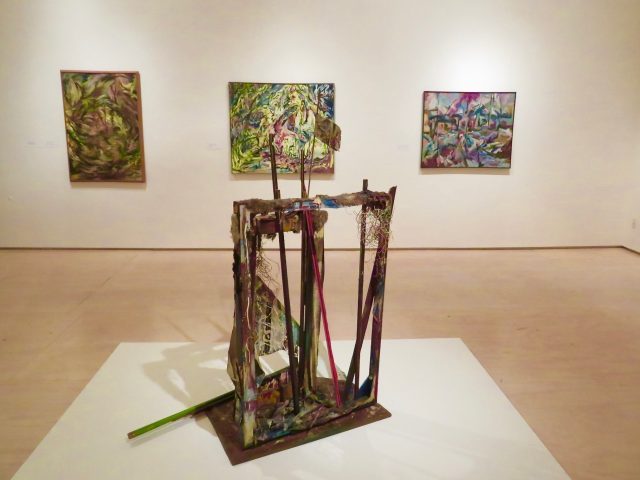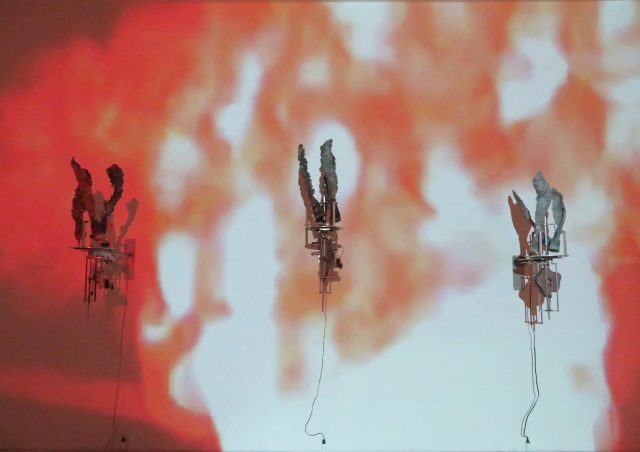
Carolee Schneemann’s early paintings and sculptures are a revelation at MoMA PS1 retrospective (photo by twi-ny/mdr)
Doc Fortnight 2018: George (Jeffrey Perkins, 2017) and Carolee, Barbara, and Gunvor, (Lynne Sachs, 2018), MoMA Film, Museum of Modern Art, 11 West 53rd St. between Fifth & Sixth Aves., 212-708-9400, Wednesday, February 21, $12, 7:30
“Art and Practice with Carolee Schneemann,” MoMA PS1, 22-25 Jackson Ave. at 46th Ave., 718-784-2084, Thursday, February 22, free with advance RSVP, 6:00
Exhibition continues at MoMA PS1 Thursday – Monday through March 11, suggested admission $5-$10, free for NYC residents
www.moma.org
www.caroleeschneemann.com
MoMA PS1’s “Carolee Schneemann: Kinetic Painting” is a revelatory exploration of the career of the immensely influential multidisciplinary artist. The seventy-eight-year-old Pennsylvania-born Schneemann will reveal yet more this week during two special programs. On February 21 at 7:30, she will be at MoMA for the world premiere screening of Lynne Sachs’s Carolee, Barbara, and Gunvor, a nine-minute short about Schneemann, Barbara Hammer, and Gunvor Nelson, which is screening with Jeffrey Perkins’s George, about George Maciunas and Fluxus, as part of “Doc Fortnight 2018: MoMA’s International Festival of Nonfiction Film and Media.” Schneemann, Perkins, and Sachs will participate in a discussion after the films; in addition, Alison Knowles will re-create her interactive 1963 piece Shoes of Your Choice. (MoMA PS1 will also be hosting “An Evening in Honor of Carolee Schneemann,” a screening and discussion on March 5 with Melissa Ragona, Jenny Jaskey, Branden W. Joseph, and the artist.) “Carolee Schneemann: Kinetic Painting” continues through March 11, an expansive two-floor survey that shines a light not only on Schneemann’s well-known feminist video and performance pieces but her exceptional paintings and sculptures. Superbly curated by Sabine Breitwieser with consulting curator Branden W. Joseph and organized at MoMA PS1 by Erica Papernik-Shimizu with Oliver Shultz, the show takes deep looks at such Schneemann works as Meat Joy, in which a group of people roll around with raw beef, chicken, and fish; Interior Scroll, in which Schneemann pulls a long strip of paper from her vagina and reads the contents; and Up to and Including Her Limits, for which she strapped herself in a harness and used her body to draw on a surface. In 1993, Schneemann declared, “I’m a painter. I’m still a painter and I will die a painter. Everything that I have developed has to do with extending visual principles off the canvas.” For the Abstract Expressionist Pinwheel, a white-gloved staff member will spin the painting upon request. Like Joseph Cornell, she made shadowbox-type works, and her collections of sharp, often aggressive detritus hang on the walls like three dimensional paintings. Colorado House is a “failed” painting turned into a freestanding sculpture. Magnetic audio tape falls out of the bottom of One Window Is Clear — Notes to Lou Andreas Salomé, a tribute to the Russian-German psychoanalyst and writer.

Carolee Schneemann’s Flange 6rpm consists of seven foundry-poured aluminum sculptures that move at six revolutions per minute (photo by twi-ny/mdr)
“My work can take substance from the materials I find,” Schneemann wrote to French poet and activist Jean-Jacques Lebel in 1964, which helps explain Blood Work Diary, a visual document of her menstrual flow. For Body Collage, a naked Schneemann, coated in wallpaper paste and molasses, rolls around in paper shreds. Her body is also one of the main subjects in Fuses, a film in which she makes love with her then-partner, James Tunney, while her beloved cat, Kitch, hangs around nearby. Kitch can be found in several works, but it’s Cluny (and later Vesper) who Schneemann gets perhaps a little too close to in Infinity Kisses. Meanwhile, Vulva’s Morphia is so hot that Schneemann includes four electric fans to cool off the thirty-five vaginal depictions, with such text as “Vulva decodes feminist constructivist semiotics and realizes she has no authentic feelings at all; even her erotic sensations are constructed by patriarchal projections, impositions, and conditioning.” That statement gets to the heart of Schneemann’s six-decade oeuvre, taking back the female body, and the power that comes with that, and redefining it, with no limits. Particularly in the era of #MeToo, “Carolee Schneemann: Kinetic Painting” is an extraordinary exhibition by an extraordinary artist who has never been afraid to make the private public, and political.